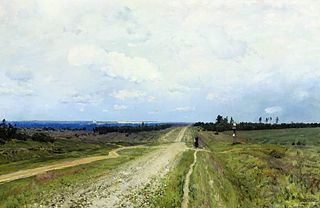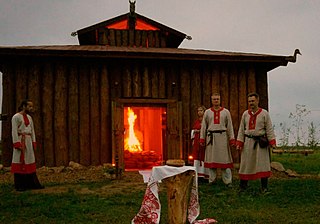Related Research Articles
Chernobog and Belobog are an alleged pair of Polabian deities. Chernobog appears in Helmold's Chronicle as a god of misfortune worshipped by the Wagri and Obodrites, while Belobog is not mentioned – he was reconstructed in opposition to Chernobog. Both gods also appear in later sources, but they are not considered reliable. Researchers do not agree on the status of Chernobog and Belobog: many scholars recognize the authenticity of these theonyms and explain them, for example, as gods of good and evil; on the other hand, many scholars believe that they are pseudo-deities, and Chernobog may have originally meant "bad fate", and later associated with the Christian devil.
Devana, Zevana, less often Zievonya is the goddess of wild nature, forests, hunting and the moon worshiped by the Western Slavs. In the sources, she was first mentioned in the 15th century by Jan Długosz, who compared her to the Roman goddess Diana. Dziewanna is also a Polish name for Verbascum, and the etymology of the word is unclear. After strong criticism from Aleksander Brückner, researchers rejected her authenticity, but nowadays it is accepted by an increasing number of researchers. Sometimes, in folk rituals, she performs together with Morana.
Stribog is a god in Slavic mythology found in three East Slavic sources, whose cult may also have existed in Poland. The sources do not inform about the functions of the god, but nowadays he is most often interpreted as a wind deity who distributes wealth.
Svarog is a Slavic god of fire and blacksmithing, who was once interpreted as a sky god on the basis of an etymology rejected by modern scholarship. He is mentioned in only one source, the Primary Chronicle, which is problematic in interpretation. He is presented there as the Slavic equivalent of the Greek god Hephaestus. The meaning of his name is associated with fire. He is the father of Dazhbog and Svarozhits.

Svetovit, also known as Sventovit and Svantovit amongst other variants, is the god of abundance and war, and the chief god of the Slavic tribe of the Rani, and later of all the Polabian Slavs. His organized cult was located on the island of Rügen, at Cape Arkona, where his main temple was also located. According to the descriptions of medieval chroniclers, the statue representing this god had four heads, a horn and a sword, and to the deity himself were dedicated a white horse, a saddle, a bit, a flag, and eagles. Once a year, after the harvest, a large festival was held in his honor. With the help of a horn and a horse belonging to the god, the priests carried out divinations, and at night the god himself rode a horse to fight his enemies. His name can be translated as "Strong Lord" or "Holy Lord". In the past it was often mistakenly believed that the cult of Svetovit originated from St. Vitus. Among scholars of Slavic mythology, Svetovit is often regarded as a Polabian hypostasis of Pan-Slavic god Perun. His cult was destroyed in 1168.

In the pre-Christian religion of Eastern and Southern Slavs, Rod is the god of the family, ancestors and fate. Among Southern Slavs, he is also known as Sud. He is usually mentioned together with Rozhanitsy deities. One's first haircut (postriziny) was dedicated to him, in a celebration in which he and the rozhanitsy were given a meal and the cut hair. His cult lost its importance through time, and in the ninth or tenth century he was replaced by Perun, Svarog and/or Svetevid, which explains his absence in the pantheon of Vladimir the Great.

Simargl or Sěm and Rgel is an East Slavic god or gods often depicted as a winged dog, mentioned in two sources. The origin and etymology of this/these figure(s) is the subject of considerable debate. The dominant view is to interpret Simargl as a single deity who was borrowed from the Iranian Simurgh. However, this view is criticized, and some researchers propose that the existence of two deities, Sěm and Rgel, should be recognized.
Khors is a Slavic god of uncertain functions mentioned since the 12th century. Generally interpreted as a sun god, sometimes as a moon god. The meaning of the theonym is also unknown: most often his name has been combined with the Iranian word for sun, such as the Persian xoršid, or the Ossetian xor, but modern linguists strongly criticize such an etymology, and other native etymologies are proposed instead.
In historical Indo-European religion, the concept of an otherworld, also known as an otherside, is reconstructed in comparative mythology. Its name is a calque of orbis alius, a term used by Lucan in his description of the Celtic Otherworld.

Nav is a phrase used to denote the souls of the dead in Slavic mythology. The singular form is also used as a name for an underworld, over which Veles exercises custody—it is often interpreted as another name for the underground variant of the Vyraj.

Yarovit, Iarovit is a Polabian god of war, worshipped in Vologošč (Circipanians) and Hobolin. Sources give only a brief description of his cult, his main temple was located in Vologošč, where there was a golden shield belonging to Yarovit. By one Christian monk he was identified with the Roman Mars.

In Slavic paganism there are a variety of female tutelary spirits associated with water. They have been compared to the Greek Nymphs, and they may be either white (beneficent) or black (maleficent). They may be called 'Navki, Rusalki, and Vily.
Jesza or Jasza is an alleged Polish god. He was first mentioned around 1405–1412 in the sermons of Lucas of Wielki Koźmin, which warned against the worship of Jesza and other gods during spring rituals and folk performances. His popularity is partly owed Jan Długosz's comparison of him to the Roman god Jupiter. However, the opinions of the 20th century and later researchers are divided with respect to the authenticity of the deity.
The Slavic creation myth is a cosmogonic myth in Slavic mythology that explains how the world was created, who created it, and what principles guide it. This myth, in its Christianized form, survived until the nineteenth and twentieth century in various parts of the Slavdom in chronicles or folklore. In the Slavic mythology there are three versions of this myth: the first version is the so-called earth-diver myth, which intertwines two main motifs: the dualistic motif – the cooperation of God and the Devil is required to create the world, and the oceanic motif – the pre-existence water, where the seed of the Earth comes from; the second version speaks about the origin of the universe and the world from the Cosmic Egg and the World Tree; the third one about creation from a dismemberment of a primordial being.
Chernoglav or Chernoglov is the god of victory and war worshipped in Rügen, probably in the town of Jasmund, mentioned together with Svetovit, Rugievit, Turupid, Puruvit and Pizamar in the Knýtlinga saga.
The fifth god was called Pizamar from a place called Jasmund, and was destroyed by fire, There was also Tjarnaglófi, their god of victory who went with them on military campaigns. He had a moustache of silver and resisted longer than the others but they managed to get him there years later. Altogether, they christened five thousand on this expedition.

Svarozhits, Svarozhich is a Slavic god of fire, son of Svarog. One of the few Pan-Slavic gods. He is most likely identical with Radegast, less often identified with Dazhbog.
Porevit, Porovit or Borovit is a Slavic god with unknown functions mentioned in only two sources: Gesta Danorum and in Knýtlinga saga. The only historical information about this god is a description of a statue depicting him that had five faces and no weapons.
Dzidzilela, Dzidzileyla, Dzidzilelya is an alleged Polish goddess. First mentioned by Jan Długosz as the Polish equivalent of the Roman goddess Venus, goddess of marriage. Nowadays, the authenticity of the goddess is rejected by most researchers, and it is believed that the theonym was created by recognizing a fragment of folk songs as a proper name.
Svarog is a Slavic god of fire and smithing mentioned in the Slavic translation of the Chronicle of John Malalas found in the Primary Chronicle as the Slavic equivalent of the Greek god Hephaestus.
References
- ↑ Людмила Викторовна Евдокимова (1998). Мифопоэтическая традиция в творчестве (in Russian). ISBN 9785882003561 . Retrieved 23 August 2014.
- 1 2 3 Kempiński, Andrzej (2001). Encyklopedia mitologii ludów indoeuropejskich[Encyclopedia of mythology of Indo-European peoples] (in Polish). Warszawa: Iskry. ISBN 83-207-1629-2.
- 1 2 3 4 5 6 7 8 Szyjewski, Andrzej (2004). Religia Słowian[Religion of the Slavs] (in Polish). Kraków: Wydawnictwo WAM. ISBN 83-7318-205-5.
- 1 2 Boris Uspenskij. Philological research in the field of Slavic antiquities. - M.: Publishing House of the Moscow University, 1982
- ↑ Max Vasmer, Этимологический словарь русского языка (М., 1964—1973), s.v. ирей.
- ↑ Елена Левкиевская (2010). Мифы и легенды восточных славян (in Russian). ISBN 9785457607705 . Retrieved 23 August 2014.
- ↑ Левкиевская, Елена (6 April 2019). Мифы и легенды восточных славян. ISBN 9785457607705.
- ↑ Gieysztor, Aleksander (1982). Mitologia Słowian (in Polish). Warsaw, Poland: Wydawnictwa Artystyczne i Filmowe. ISBN 83-221-0152-X.